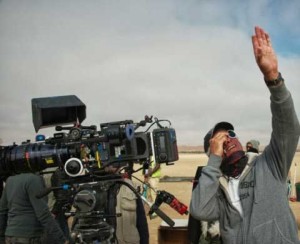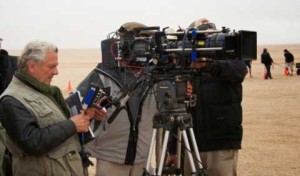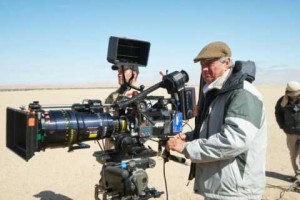
Originally, Fury Road was intended to be shot near Broken Hill in New South Wales, Australia. However, several years of unusually heavy rainfall caused the desert in the area to bloom with wildflowers making it unsuitable for the film’s wasteland setting and production was moved to Namibia. The coastal deserts of that African country are among the most formidable in the world, with sand dunes 1,000 feet high and 20 miles long. Frequent sandstorms and intense heat required special precautions by the camera crew.
“I’d shot plenty of film-negative films in deserts and jungles under severe conditions, but never digital,” Seale said. “So I was a bit worried, but I had a fantastic crew of people who had done that… had worked with digital cameras in jungles, deserts, dry, heat, wet, moist, whatever. They were ready and put together full precaution kits of rain covers, dust covers and even heat covers to take the heat off the cameras in the middle of the day.”
“We were using a lot of new gear.” Seale added. “Everything that our crew did in pre-production in Sydney and took to Namibia worked very, very well for the entire time. Our time loss through equipment was minimal.”

The original Mad Max is remembered for its gritty look. Fury Road took a different route due to the film’s heavy use of visual effects. “The DI and the post work is so explicit; almost every shot is going to be manipulated in some way,” Seale explained. “Our edict was ‘just shoot it.’ Continuity of light wasn’t really a question. We knew that the film would be cut very quickly, so there wouldn’t be time to analyze every shot. Intercutting between overcast and full sun wasn’t going to be a problem. On this film, the end result controlled the execution.”
In order to provide maximum image quality and flexibility for postproduction manipulation, Seale and his crew chose to operate the Alexa cameras in ARRIRAW mode. That, the cinematographer noted, made Codex an obvious choice.
“The choice to go with Codex was definite for the quality of the recording and postproduction considerations,” Seale said. “Everyone said Codex was the recording device that we had to have. Once again, we were a little worried about desert heat and desert cold. It changes so much from night to day. And during the day, we had dust storms, dust flying everywhere. We sometimes had moisture in the air. But the Codex systems didn’t fail us. They came straight through with flying colors and, in post, they are very happy with the results.”
 Shooting digitally with Codex offered an advantage over shooting on film as it avoided the need to reload cameras with film negative in the blowing winds of the desert. “There is a certain amount of paraphernalia needed to shoot digitally, but our crew was used to that,” Seale said. “They built special boxes to put everything in. They had little fans. They had inlet and outlet areas to keep air circulation going. Those boxes were complete. Cables came out and went to the camera. If we were on the move, the boxes were bolted down so that they were out of the way and didn’t fall off. Sometimes we sat on them to get our shot.”
Shooting digitally with Codex offered an advantage over shooting on film as it avoided the need to reload cameras with film negative in the blowing winds of the desert. “There is a certain amount of paraphernalia needed to shoot digitally, but our crew was used to that,” Seale said. “They built special boxes to put everything in. They had little fans. They had inlet and outlet areas to keep air circulation going. Those boxes were complete. Cables came out and went to the camera. If we were on the move, the boxes were bolted down so that they were out of the way and didn’t fall off. Sometimes we sat on them to get our shot.”
RF interfaces were used with the Alexa cameras to transmit images to a command vehicle for monitoring by the director. Miller was not only able to review shots, he could edit material to determine what further coverage was needed. “For George, it was a godsend,” Seale said. “That refined the film shooting and made it a lot quicker than the normal procedures.”
It was that sort of flexibility that made shooting with Alexa and Codex so appealing, Seale added. “I was a great advocate of digital ten or 15 years ago when it started to come in,” he said. “Film negative is a beautiful image recording process, but it’s 120 years old and you get scratches and dead flies caught in the reels. It’s pretty archaic.”
“I think the way digital has caught on is extraordinary. Its R&D is vertical, where film development has stopped. The ability of digital to record images coupled with the DI, where you can change it, manipulate it, allows you do anything you like. I know with Mad Max, it won’t look anything like a ‘good film image’ and it won’t look anything like a ‘good digital image’… it will look like its own image. I think that’s the wonder of it.”





